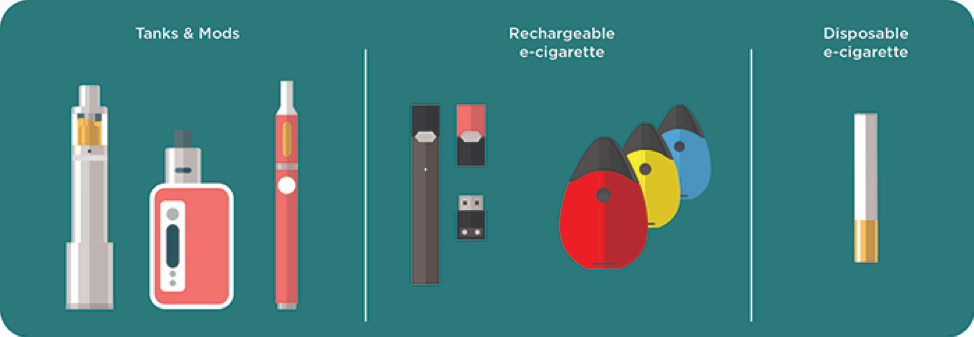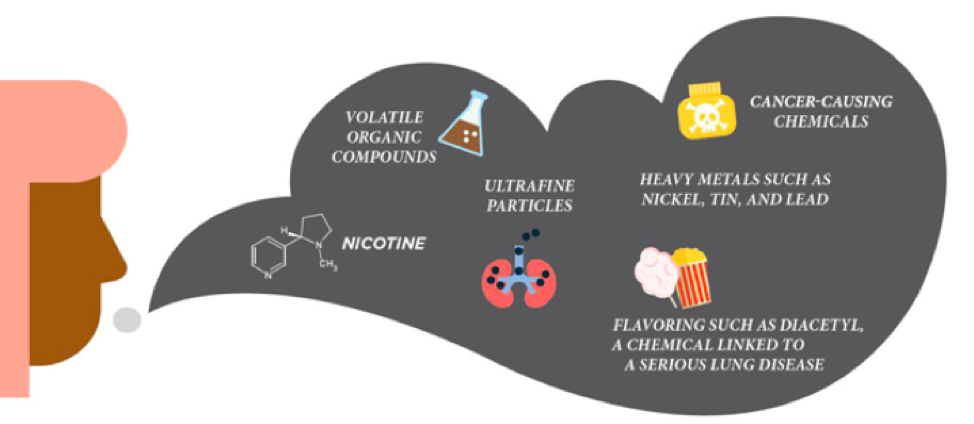Let’s get straight to the point. Smoking is the most preventable cause of death in Philadelphia and the nation (1).
All cigarettes, cigars, and other tobacco products damage your body and can result in life-threatening disease.
Thankfully, I believe that most Philadelphians are aware of this. A survey from 2019 found that 2% of Philadelphia high-schoolers use cigarettes, which is well below the 18.5% of adults in Philadelphia who do smoke. We are well below the national average of high schoolers who smoke as well, and that is excellent! (1)
However, we know that cigarettes aren’t as popular as they used to be. Instead, many teens are trying vaping.
Since vaping is basically brand new compared to cigarettes, there is a lot of misleading information out there about it. While it is not the same as other tobacco products, vaping is dangerous and can permanently damage your lungs.
Let’s talk about the truth about vaping and what the big companies won’t put on their package labels for you.
What is Vaping?
Vaping is the use of an e-cigarette (e-cig) that produces a gas-like mixture that you inhale containing nicotine and other chemicals, which are either flavorings or preservatives. E-cigs come in many shapes and sizes, including those that look like cigarettes, pens, tanks, and rechargeable USB sticks.

(2)
While it is called “vaping”, the gas that comes out of an e-cig is not water vapor. The companies that make the e-cigs call it vapor because it sounds harmless. That is a lie - it is actually an aerosol.
Aerosols are a mixture of air and tiny liquid droplets. You may have used aerosols if you’ve ever used a can of whip cream or any spray-on deodorant like Axe body spray.
The e-cig creates an aerosol by rapidly heating up a liquid or solid to high temperatures. For the most part, the liquid comes from a cartridge or other refillable source. Despite some labels claiming that the products are nicotine-free, scientists found that the liquid almost always contains nicotine. (2)
In recent years, we have seen an increase in vaping among teens. The same study from 2019 that saw a 2% use of cigarettes by Philadelphia high-schoolers also reported that 7% use some form of e-cigs (1).
On a more national level, it was reported that 27.5% of American high-schoolers and 10.5% of American middle-schoolers were using an e-cig in 2019 (1).
What Vaping Does to You
Let’s get back to that aerosol I mentioned earlier.
All e-cigs work by heating a compound and creating an aerosol that you inhale. The mixture of air and liquid droplets carries nicotine and other chemicals into your lungs, where they are absorbed through your lungs and into your bloodstream.
Nicotine is the highly addictive chemical in tobacco. Like many drugs, it only creates a short-lived pleasure, leaving you wanting more soon after and causing addiction. Addiction is a disease that causes physical and mental problems for you and those that care about you. Nicotine is also harmful to pregnant women and the developing brain of young adults. (2)
If that wasn’t scary enough, the nicotine from vaping decreases the strength of your immune system in your airways, making you vulnerable to any type of illness that attacks your lungs (3). That includes coronavirus!
You should worry about those other chemicals in the e-cig liquid too. They include chemicals like heavy metals (lead, nickel, tin), cancer-causing toxins, ultra-fine particles that we have yet to truly understand, and artificial flavorings that can put you at risk for lung disease (2).
Some flavorings contain a chemical called diacetyl, a common butter-flavoring used on movie theater popcorn. Diacetyl causes “popcorn lung”, where your lungs get filled with tiny scars that destroy the lung tissue (4). Despite the fun name, trust me when I say that popcorn should belong in your stomach.

(2)
Even if you are using e-cigs that claim to be nicotine-free, you are still putting other dangerous chemicals and metals found in the liquid into your lungs, slowly poisoning them.
Bottom line: your lungs are not designed to handle anything but air in them.
Is it Safer than Cigarettes?
Not really.
There are nearly 7,000 dangerous chemicals in cigarettes that can cause cancer almost anywhere in your body, not just your lungs (5).
While e-cigs don’t have thousands of dangerous chemicals, they have enough dangerous chemicals to cause damage to your lungs that you will never be able to truly fix.
We have also seen a dangerous trend of e-cig users eventually taking up smoking.
Among Philadelphians between the ages of 18 and 34 that use e-cigs, 42% also use cigarettes. For those under the age of 18 using e-cigs, 24% currently smoke cigarettes, with 34% stating that they have tried cigarettes in the past. (1)
Basically, we’ve seen that if you are someone who vapes, you are 3.5 times more likely to take up smoking compared to someone who does not (6). E-cigs are a step in the wrong direction towards smoking, not away from it.
Vaping Can Send You to the Hospital
Around July of 2019, doctors around the nation began to see their fears of vaping come true.
Young users of e-cigs arrived in emergency rooms with shortness of breath, chest pain, and a cough. Images showed damage throughout their lungs, preventing them from breathing effectively. Yet, they did not have the flu or some other disease. The only thing these young adults had in common was vaping. (7)
This new disease in young, otherwise healthy patients was labeled e-cigarette or vaping product use-associated lung injury, abbreviated EVALI.
As of February 18th, 2020, the Centers for Disease Control and Prevention have reported 2,807 cases of EVALI, with 68 deaths (7).
Doctors and researchers believe the main cause to be a compound called vitamin E acetate (7). Vitamin E acetate is found naturally in food and is needed for survival. However, putting vitamin E acetate in your lungs is very different than putting it in your stomach!
Many of these cases were linked to patients using liquids or cartridges for their e-cigs that had been handmade to contain THC, the active chemical in cannabis (aka marijuana or weed), and vitamin E (7). Something in the THC vape liquid, whether it be the vitamin E acetate or one of the other compounds in the mixture, caused these terrible lung injuries to young adults.
We have yet to prove exactly what causes EVALI, but that only increases the reasons why you should avoid vaping altogether!
Closing Thoughts
Think about when you are rowing or running and how much air you breathe in and out to keep your body moving. It’s amazing how much power you can draw from the oxygen you breathe in.
Both smoking and vaping destroy your lungs. As an athlete, you should not want to sabotage your performance like that. Rowing is all about working towards your best self, but smoking or vaping prevents you from achieving that.
As a future doctor, it’s my duty to provide high quality, accurate information about health topics. Vaping may be new compared to smoking, but we know enough now to see the pain it can cause you. Beyond sports, smoking and vaping can ruin your long-term health, making serious diseases more likely. It is important to know these risks.
And so, I encourage you to take charge of your health!
If you want to know more about smoking or vaping, or perhaps help someone you care about who smokes or vapes quit, check out these helpful resources:
- Smoke Free Philly for a one-stop website for information about smoking and vaping, including tools to help quit.
- Call 1-800-QUIT-NOW, a free service for Pennsylvanians where you can speak with a professional about quitting tobacco products. For Spanish speakers, call 1-855-DEJELO-YA.
- Centers for Disease Control have a thorough listing of informative articles about smoking, vaping, and their related health conditions.

References
- Farley, Thomas. 2020. Smoking and Vaping in Philadelphia. Philadelphia Department of Public Health. http://smokefreephilly.org/wp-content/uploads/2020/02/CHART-v5e2.pdf
- Office on Smoking and Health, National Center for Chronic Disease Prevention and Health Promotion. 2020. About Electronic Cigarettes. Centers for Disease Control and Prevention. https://www.cdc.gov/tobacco/basic_information/e-cigarettes/about-e-ciga…
- Salathe, Matthias et.al. 2015. Nicotine in Electronic-Cigarettes Causes Inflammation, Airway Hyperreactivity and Lung Tissue Destruction. American Journal of Respiratory and Critical Care Medicine 2015;191:A4030. https://www.atsjournals.org/doi/abs/10.1164/ajrccm-conference.2015.191…
- Popcorn Lung: A Dangerous Risk of Flavored E-Cigarettes. 2020. American Lung Association. https://www.lung.org/blog/popcorn-lung-risk-ecigs#:~:text=When%20inhale….
- Patnode CP et. al. 2015. Behavioral Counseling and Pharmacotherapy Interventions for Tobacco Cessation in Adults, Including Pregnant Women: A Review of Reviews for the U.S. Preventive Services Task Force. Evidence Synthesis No. 134. AHRQ Publication No. 14-05200-EF-1. Rockville, MD: Agency for Healthcare Research and Quality; 2015. https://www.ncbi.nlm.nih.gov/books/NBK321744/.
- Soneji S, Barrington-Trimis JL, Wills TA, et al. 2017. Association Between Initial Use of e-Cigarettes and Subsequent Cigarette Smoking Among Adolescents and Young Adults: A Systematic Review and Meta-analysis. JAMA Pediatr. 2017;171(8):788. doi:10.1001/jamapediatrics.2017.1488. https://pubmed.ncbi.nlm.nih.gov/28654986/.
- Office on Smoking and Health, National Center for Chronic Disease Prevention and Health Promotion. 2020. Outbreak of Lung Injury Associated with the Use of E-Cigarette, or Vaping, Products. Centers for Disease Control and Prevention. https://www.cdc.gov/tobacco/basic_information/e-cigarettes/about-e-ciga…